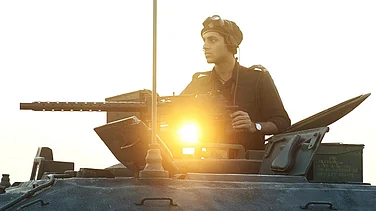A rumour spread that ghosts were roaming, entering homes, and beating people. The ghosts, all female, had long hair, wore white dresses, face masks, iron claws, springs in their boots and would jump in the air. Soon, people started claiming sightings, saying they would start running after the spirits armed with whatever they could lay their hands upon. The ghost chase continued across the Valley in the cold autumn nights of 1993. Those days, when killings would take place every day, the emergence of ghosts added to the dread.
People would call it “Operation Bhoot”. They believed it was launched by security forces to create fear among the people. Some would call the ghosts rantas, a female humanoid creature whose natural habitat was the forests and hills of Kashmir.
She would approach a house and shout the name of the owner. The house owner would raise an alarm and his neighbours would rush to his help, and the frenetic ghost chase would begin. Locality after locality, village after village, ghosts would show up every night, to be followed by new stories about their appearance in the local gossip. If in one locality a ghost would have been seen jumping from one rooftop to another, residents of another locality would claim their ghosts could fly, and in another, they would have beaten residents.
ALSO READ: Horror As The Theme Of Our Lives
Soon, people started keeping vigil, forming volunteer groups to roam around their localities at night. In many cases, volunteer groups ended up attacking each other in the confusion.
Those days, everyone was chasing ghosts. But ghosts being ghosts, they would lead the people on a wild ghost chase, before disappearing into thin air. The frenzy ended after complaints of ghost sighting suddenly subsided.
Psychiatrists say fear is more infectious than anything else, and it spreads faster than the Omicron variant of Covid, especially in communities already facing an uncertain situation who are susceptible to fear. One needs to have a certain amount of fear to live, they say. But once fear overwhelms people, it leads to overreaction, when they start seeing ghosts all over the place.
In Kashmiri literature, there are ample examples of ghosts like rantas, daen (witch), yach (male ghost), etc. No wonder rebellious girls are called rantas. Elders would mention them to put children to sleep. But when blasts, encounters, killings and crackdowns became routine, they faded away. New ghosts started turning up. On January 21, 1990, the CRPF fired at protesters on Gaw Kadal bridge, killing 51 and wounding hundreds. For many years after this, people believed the bridge was haunted by spirits. Locals reported sighting ghostly apparitions and hearing strange voices on the bridge.
The oldest ghost in Kashmir dates back to 1947. Hari Niwas Palace on the foothills of the Zaberwan range facing Dal Lake has the distinction of being a ghost house in Kashmir since the partition of the sub-continent. It is from Hari Niwas palace the last Dogra ruler of Jammu and Kashmir Hari Singh had to flee Kashmir after stepping into the palace in 1947. Former Chief Minister Ghulam Nabi Azad lost Chief Ministership after making Hari Niwas an official residence in 2007, and Omar Abdullah who operated from Hari Niwas Palace in 2014 as Chief Minister, returned to the palace in 2019 as a prisoner.
Hari Niwas Palace was built by Maharaja Hari Singh for his wife Tara Devi. It is said the Maharaja had the palace built at the location despite being told by priests that the area was the abode of Hindu goddess Shiksha Devi, making the construction of the palace there inauspicious. The Maharaja went ahead with the plan nonetheless, but had to soon flee Kashmir, in 1947, never to return. After 1947, the palace was renovated many times and then abandoned. In the 1980s, the building was used by the CID department. Then they too abandoned it.
By 1990, Hari Niwas began to signify death and torture to Kashmiris. That year, BSF used it as an interrogation centre. In its 1993 report, Human Rights Watch said people held in Hari Niwas and other torture centres of Kashmir would be severely beaten and given electric shocks on the chest, genitals and feet. Kashmiri youth interrogated in Hari Niwas narrated harrowing tales of torture.

After BSF left it, CRPF took over. Some years later, CRPF also abandoned it and the building was not put to any good use. In 2005, then chief minister Ghulam Nabi Azad ordered its renovation, adding four presidential suites, a prime minister’s suite, a VVIP guest house and scores of bedrooms. In 2007 he moved to the palace, making it the CM’s official residence.
ALSO READ: The Ghost As A Metaphor In Bengali Cinema
In less than a year, in 2008, Kashmir saw massive protests. The Peoples’ Democratic Party pulled its support from the Congress-led coalition government. Azad had to resign and leave the palace. Later, the protocol department took over. In September 2014, the then CM Omar Abdullah briefly ran his government from the palace after floods submerged Srinagar and all government buildings. On August 5, 2019, when Article 370 was abrogated, Abdullah was arrested and shifted to this palace. Hari Niwas was turned into a sub-jail and Abdullah spent nearly a year in it.
The government has now again handed it over to the protocol department.
***
Meanwhile in September 2013, ghosts arrived in south Kashmir. On September 29, 2013, Haseena Begum was in her house when she heard stones raining on her tin roof in Nowgam village of south Kashmir’s Anantnag district. She got terrified, suffered a cardiac arrest and died. People called these nocturnal stone-throwing intruders ghosts. The phenomenon soon spread to different parts of south Kashmir. In the J&K Assembly, Congress leader Ghulam Hassan Mir brought the issue up for discussion. “Residents of some south Kashmir villages are being harassed by ‘ghosts’ these days.” The police, however, said thieves operating in different areas would carry out these attacks masquerading as ghosts to create panic.
ALSO READ: The ‘Spirit’Of Filmmaking
Four years later, in October 2017, ghosts surfaced in a new form across Jammu and Kashmir, this time as braid choppers. Following several incidents in which braids of women would allegedly be chopped while they were asleep, people formed vigilante groups in their localities to catch the ghosts. They armed themselves with axes, sickles, wooden boards and cricket bats. In one case, a girl claimed a man had entered her room by tearing down a wall, chopped her hair and escaped through the hole. But there was not even a crack on the wall. The girl was sleeping with her parents, who knew nothing about it. They only heard of the alleged incident from their daughter. That year, police registered 105 FIRs of braid chopping across the Kashmir Valley.
In some places, like in Sopore police district, around 55 km from Srinagar, clashes broke out between police and residents after the latter reported an incident of braid chopping on October 15, 2013. Police resorted to shelling tear gas to disperse the protesters, who retaliated with stones. The separatists were quick to blame the government, alleging there was a fear psychosis as people were facing threat to their dignity and honour.
ALSO READ: Resident Evil: The Zombie Apocalypse In Goa
Those who suffered the most during this time were lovers and schizophrenics and aimless wanderers. On October 3, 2017, at Darbal, Parimpora in Srinagar, a schizophrenic, Mohammad Maqbool Shah, was beaten up by people on suspicion of being a “braid-chopper”. On October 19, 2017, special police officer Rayees Ahmed was beaten up at Hazratbal shrine in Srinagar on the same allegation. He had gone there to meet his brother, who was pursuing MA at Kashmir University. On the same day, a deaf and dumb person, Mohammad Amin of Humhama, was thrashed by a mob at village Arigam in Budgam. Again, he was accused of being a braid chopper.
At village Kujar in Ganderbal, people thrashed one Muzaffar Ahmad Wani. Upon investigation, police found the man had come to meet his girlfriend in the village. People in Kupwara district caught a woman and handed her over to police, suspecting her of the same crime. Police later found out that the woman was another vagabond.
On October 18, 2017, residents of Sheeri Bla in Baramulla district of north Kashmir beat up three people on the same allegation. Police rescued them and took them into custody. They were identified as Army personnel in civvies who were on their way to the market.
In all, there were 200 incidents of braid chopping reported in Jammu and 600 in Kashmir. Police described the incidents as a nefarious design to keep Kashmiri women confined to four walls, what with the presence of women on streets of Kashmir falling drastically in October 2017. Soon after, the braid choppers vanished.
ALSO READ: An Allegory Written In Blood
Later, the CID wing of Jammu and Kashmir Police came up with a 30-page report on the braid chopping ghosts, named Braid Chopping—a detailed analysis. It termed the incidents as mere illusion, saying you cannot arrest anyone as it is like chasing a ghost. It concluded by describing the incidents as, “a blind man in a dark room looking for a black cat that isn’t there”.
(This appeared in the print edition as "A Shadowy Hand")
ALSO READ


























